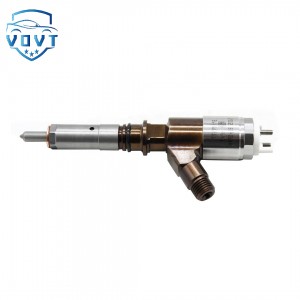New High Quality Diesel Injector 7C-4173 0R-2922 7C-4174 0R-0906 7C-4184 0R-2924 7C-4175 For CAT 3500A
Products Description
| Reference. Codes | 3500A |
| Application | 3500A |
| MOQ | 4PCS |
| Certification | ISO9001 |
| Place of Origin | China |
| Packaging | Neutral packing |
| Quality Control | 100% tested before shipment |
| Lead time | 7~10 working days |
| Payment | T/T, L/C, Paypal, Western Union, MoneyGram or as your requirement |
What factors need to be considered when optimizing the material selection of fuel injectors?
1. Work environment adaptability
1. High temperature resistance
Scenario: The fuel injector works near the engine combustion chamber and withstands high temperatures for a long time (especially diesel injectors, the temperature can reach above 300℃).
Material requirements:
High-temperature resistant alloys (such as martensitic stainless steel, nickel-based high-temperature alloys) must be used for core components such as valve body, needle valve, etc. to avoid softening, deformation or oxidation of materials due to high temperatures, affecting sealing and jet accuracy.
Seals (such as O-rings) must be made of silicone rubber, fluoroelastic or metal sealing materials to prevent aging and failure at high temperatures.
2. Corrosion resistance
Scenario: Sulfides, additives and acidic substances produced by combustion (such as water vapor reacts with sulfur to form sulfuric acid) will corrode the metal surface.
Material requirements:
Components that contact fuel (such as nozzles, oil channels) must use corrosion-resistant stainless steel (such as 316L stainless steel) or surface coating (such as nitriding, nickel-plated phosphorus) to reduce the impact of chemical corrosion on flow characteristics.
For special fuels such as ethanol gasoline, the compatibility of the material and alcohols should be considered (such as avoiding the use of ordinary rubber and using fluoroelastomer or polytetrafluoroethylene).
3. Abrasion resistance
Scenario: Mechanical impurities in fuel (such as dust, metal particles) or high-pressure fuel flow will erode precision components such as nozzles, needle valves, etc., resulting in wear.
Material requirements:
Key parts such as nozzle holes and needle valve sealing cone surfaces must be made of cemented carbide (such as tungsten carbide) or ceramic materials (such as silicon nitride) to extend the service life by using their high hardness characteristics.
Surface treatment processes (such as nitriding, plating) can further improve surface hardness and reduce wear rate.
2. Mechanical performance matching
1. Strength and Stiffness
Scenario: The fuel injector needs to withstand high-pressure fuel (such as the pressure of the common rail system can reach more than 200MPa) and high-frequency opening and closing mechanical stress.
Material requirements:
High-strength alloy steel (such as 42CrMo) is required to ensure that there is no deformation or cracking under high pressure.
Needle valve assembly must have high stiffness to avoid jet delays or drip caused by elastic deformation.
2. Fatigue durability
Scenario: The injector needle valve can be opened and closed dozens of times per second, and long-term high-frequency movement can easily cause fatigue and fracture.
Material requirements:
For moving parts such as needle valves and springs, high fatigue strength materials (such as oil-quenched tempered alloy spring steel), and the grains are refined through precision heat treatment (such as vacuum quenching) to improve fatigue resistance.
To avoid defects such as pores and inclusions inside the material, the density of the material can be improved through forging or powder metallurgy.
3. Fuel compatibility
1. Chemical compatibility
Scenario: The chemical properties of different fuels (such as gasoline, diesel, biofuel) vary significantly, and may swell or corrode the material.
Material requirements:
Rubber components such as seals, O-rings, etc. need to choose compatible rubbers according to the fuel type (such as nitrile rubber is suitable for gasoline, and fluoroelastomer is suitable for diesel and ethanol fuel).
Plastic components (such as sensor housing) need to be made of fuel-resistant polyformaldehyde (POM) or nylon (PA) to avoid softening or cracking.
2. Lubricity matching
Scenario: The lubricity of the fuel itself affects the wear of moving parts (such as needle valves and valve seats).
Material requirements:
For fuels with poor lubricity (such as low-sulfur diesel), self-lubricating materials (such as adding molybdenum disulfide to the coating) or optimize surface roughness to reduce friction and wear.
4. Processing technology and cost
1. Processability
Scenario: Precision components of the fuel injector (such as the diameter of the nozzle hole is only 0.1-0.3mm) require high-precision processing.
Material requirements:
Be preferred to choose easy-to-cut materials (such as easy-to-cut stainless steel with added sulfur and lead), or adjust the hardness through heat treatment (such as aging treatment), so as to facilitate precision molding of electric spark processing (EDM), laser hole drilling and other processes.
2. Cost control
Scenario: High-end materials (such as ceramics, nickel-based alloys) have high costs and need to balance performance and economy.
Strategy:
Key parts (such as nozzles) are made of expensive high-performance materials, while non-critical structural parts (such as shells) are made of low-cost aluminum alloys or ordinary steel.
Surface treatment technology (such as plating) is used to replace the overall material upgrade, reducing costs while improving local performance.
5. Environmental protection and reliability
1. Environmental Protection Regulation Compliance
Requirements: The materials must comply with environmental regulations such as RoHS (restricted hazardous substances), REACH (chemical registration), and avoid the use of toxic elements such as lead and cadmium.
Alternative solution: Use lead-free stainless steel, water-based plating and other environmentally friendly materials.
2. Long-term reliability verification
Test requirements: New materials need to pass high-temperature aging test, corrosion cycle test, fatigue life test, etc. to ensure stable performance over the entire engine life cycle.
Data support: refer to industry standards (such as ISO 19403, SAE J2715) or benchmark the performance of competitor materials to avoid injector failure due to material defects.























